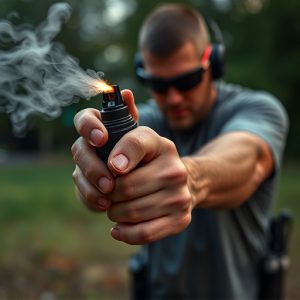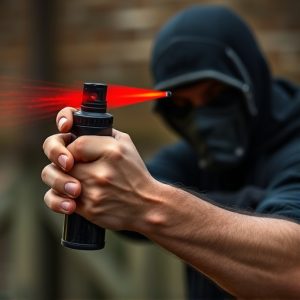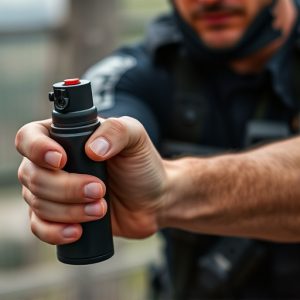Tactical Pepper Spray: Bear vs Personal – Which is Best for You?
Tactical pepper spray comes in two distinct types: bear spray and personal pepper spray, each design…….
Tactical pepper spray comes in two distinct types: bear spray and personal pepper spray, each designed for specific purposes. Bear spray deters aggressive bears at a distance, providing crucial seconds to retreat during outdoor encounters, while personal pepper spray focuses on close-range human defense with stronger concentration for urban or crowded settings. The choice between them depends on the user's needs; bear spray for outdoor wildlife protection and personal pepper spray for everyday carry as a compact self-defense tool in high-crime areas.
“Unleashing protection in a compact form, tactical grade pepper spray dispensers have become indispensable tools for outdoor enthusiasts and personal safety advocates alike. This comprehensive guide explores two prominent varieties: bear spray, designed for wild adventures, and personal pepper spray, tailored for everyday carry. We delve into the differences, benefits, and unique applications of each, helping you choose between bear spray vs. personal pepper spray to ensure you’re prepared for any scenario. Whether navigating rugged terrain or navigating urban streets, discover the best fit for your protection needs.”
- Understanding Tactical Pepper Spray: A Comprehensive Overview
- Bear Spray: The Outdoor Adventure Companion
- Personal Pepper Spray: Protection for Everyday Carry
- Comparing Bear Spray vs Personal Pepper Spray: Which is Right for You?
Understanding Tactical Pepper Spray: A Comprehensive Overview
Tactical pepper spray is a specialized tool designed for law enforcement, military, and personal defense purposes. Unlike bear spray, which is formulated to deter wildlife, personal pepper spray is specifically crafted to incapacitate humans. The primary active ingredient in most tactical grade sprays is capsaicin, the compound that gives chili peppers their heat. This chemical irritates the eyes, nose, throat, and skin, leading to temporary blindness, difficulty breathing, and extreme discomfort, allowing users to escape or subdue an attacker.
The key difference between bear spray and personal pepper spray lies in their application and target audience. Bear spray is designed for outdoor use against aggressive animals, requiring a wide area of coverage and a milder concentration to deter without causing serious harm. In contrast, personal pepper spray is intended for close-quarters combat, focusing on quick incapacitation with a stronger concentration over a smaller area. This distinction makes personal pepper spray a more versatile option for self-defense in various settings, from urban streets to indoor facilities.
Bear Spray: The Outdoor Adventure Companion
Bear spray, a specialized pepper spray designed for outdoor activities, has emerged as an indispensable tool for adventurers and outdoor enthusiasts. Unlike traditional personal pepper spray, bear spray is formulated to deter aggressive bears, making it a game-changer for hikers, campers, and those exploring remote areas. Its unique formula and application method ensure a wide cone of protection, allowing users to maintain safe distances from potential bear encounters.
When considering Bear Spray vs Personal Pepper Spray, the key difference lies in their primary objectives. Personal pepper spray is tailored for self-defense against humans, focusing on close-range effectiveness. In contrast, bear spray is engineered to create a barrier and deter bears at a distance, providing users with crucial seconds to retreat or seek safety during wildlife encounters. This specialized nature makes bear spray an invaluable addition to any outdoor gear, offering peace of mind and enhanced security in bear country.
Personal Pepper Spray: Protection for Everyday Carry
Personal pepper spray is a compact and discreet self-defense tool designed for everyday carry, offering individuals an additional layer of protection in various situations. Unlike bear spray, which is formulated to deter larger wildlife, personal pepper spray is tailored to incapacitate smaller threats like assailants or aggressors. Its non-lethal formula creates a temporary yet powerful defense, allowing users to escape and seek help.
Unlike bear spray that has a broader range and is more suitable for outdoor activities, personal pepper spray is ideal for close-quarters encounters within urban settings. It’s legal in many places and easily portable, making it an attractive option for those seeking peace of mind while traveling or navigating high-crime areas.
Comparing Bear Spray vs Personal Pepper Spray: Which is Right for You?
When considering self-defense options, choosing between bear spray and personal pepper spray depends on your specific needs and environment. Bear spray is designed for outdoor situations, particularly encounters with bears or other large wildlife. Its wide reach and powerful aerosolization make it effective at a distance, ideal for deterring aggressive animals. It’s less useful in close-quarters combat scenarios against humans.
Personal pepper spray, in contrast, is tailored for human confrontations. It delivers a concentrated burst of capsaicin directly into the eyes, causing temporary blindness and disorientation. This type of spray is more effective at close range and is suitable for self-defense in urban or crowded environments. It’s also generally less harmful to bystanders and wildlife compared to bear spray.
When deciding between bear spray and personal pepper spray, understanding their unique applications is key. Bear spray is an excellent choice for outdoor enthusiasts facing wild animals, offering a broader range and longer reach. In contrast, personal pepper spray is designed for self-defense scenarios, providing users with quick and effective protection in close-quarters situations. Both have their merits, but the right choice ultimately depends on your specific needs, whether it’s exploring nature or ensuring personal safety in urban environments. By considering these factors, you can make an informed decision to protect yourself effectively in various settings.


